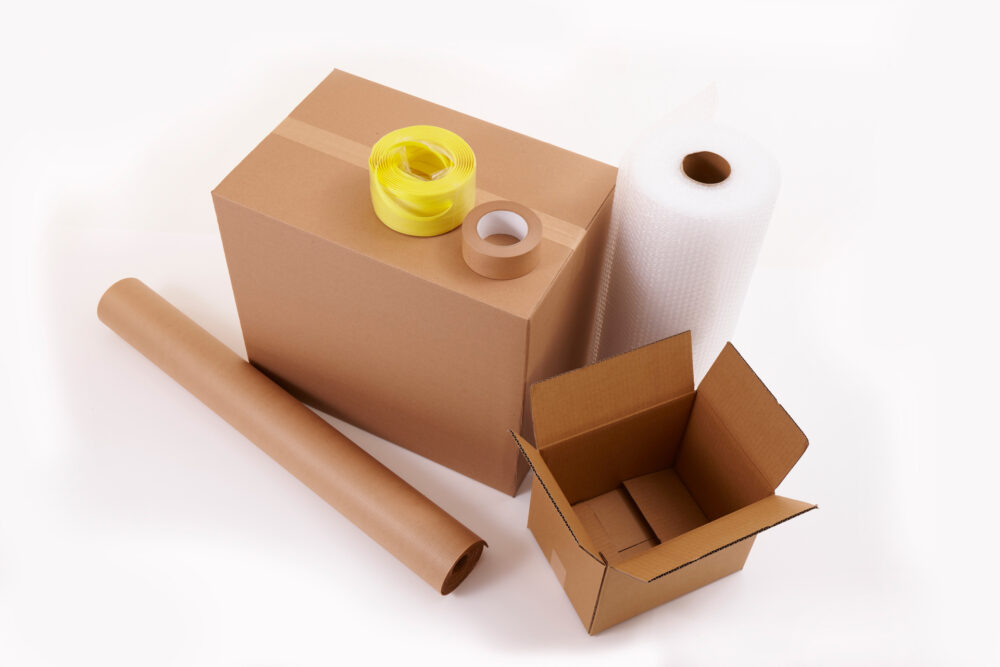Let’s be honest here, every relocation can be very chaotic if not planned well, not to mention the boxing-up process. That’s why it is important to create a comprehensive packing schedule for moving on time. This way, you can mitigate mishaps more efficiently and ensure nothing is left behind or forgotten. Let us guide you through this process and ensure a smooth relocation experience.

How to Create a Packing Schedule for Moving?
Start preparing a moving and packing plan 4-6 weeks in advance with a well-organized relocation binder and a thorough decluttering of the old home. Conduct a moving company research so you can choose a legitimate company. As you get closer to the big day, create a household inventory and gather all necessary supplies.
Implement a strategic boxing-up schedule, prioritizing non-essentials and delicate items. In the final weeks, confirm details with your cross-country movers and handle utility transfers. When the big day comes, oversee the loading process and plan unpacking at your new home. Remember to book a reputable white glove moving service on time and ensure a stress-free relocation experience.
Start the Moving Preparations 4-6 Weeks Ahead of Time
When planning a relocation, starting early is key to success. However, according to Forbes, over 50% of Americans reported that their relocation was unforeseen. This early window provides ample time to organize, pack, and address any unexpected challenges.
Early preparation ensures that you can research and hire the best company, secure necessary supplies, and deal with paperwork without the stress of tight deadlines. This period also allows you to gradually adapt to the upcoming change, reducing the anxiety that often accompanies this process.
Try to Organize the Important Paperwork by Creating a Moving Binder
The foundation of a well-organized relocation is a good binder. Start by compiling all important documents such as moving quotes, rental or purchase agreements, and personal records like birth certificates and passports.
Use tabs to categorize this paperwork for easy access. Storing contracts, receipts, and inventory lists in your binder keeps everything in one place, ensuring you’re always prepared and informed throughout the whole process.
Decluttering Before the Relocation Is a Must
Downsizing for the move involves sorting through all your belongings and deciding what to keep, sell, donate, or discard. This process even reduces relocating costs by decreasing the number of items to transport. Consider hosting a garage sale or donating to local charities, which can be both financially beneficial and socially responsible. These decluttering tips also offer a chance to start fresh in your future home, bringing only the items that add value to your new lifestyle.
Research the Moving Companies and Make an Informed Decision
Choosing the right company is vital when cross-country moving. So, dedicate time to researching various movers, focusing on customer reviews, services offered, and pricing. A crucial step is to verify the company’s legitimacy and reliability through the Federal Motor Carrier Safety Administration (FMCSA) website. This ensures that your chosen partner is licensed and insured, providing peace of mind that your belongings are in safe hands. Remember, a well-informed decision now can prevent potential headaches and some common mistakes later.

Organize Your Stuff and Make an Inventory Checklist 3-4 Weeks Before the Move
When long-distance moving, it’s crucial to know exactly what you’re taking with you. That’s why it’s important to create a detailed inventory of those belongings. This task might seem overwhelming at first, but a room-by-room approach simplifies it.
Document each item, focusing especially on those of high value. Photograph these objects and note their current condition. This inventory becomes essential for moving insurance claims. Should anything get lost or damaged, you have a clear record to support your case.
Gather the Essential Packing Materials
The importance of having the right packing materials can’t be overstated. Quality supplies will protect your belongings and ensure everything reaches you safely. They also make packing, loading, and unloading much easier and more organized. More importantly, you risk damage to your possessions and relocation stress without adequate materials. On that note, here’s a list of supplies needed for an efficient relocation experience:
- Sturdy boxes – invest in high-quality crates in various sizes. Consider getting specialty containers for dishes, artwork, mirrors, or clothing to prevent them from wrinkling.
- Bubble wrap and foam peanuts – essential for cushioning and protecting fragile items.
- Clean paper – use it to wrap glasses, bowls, and other breakables before storing them away.
- Stretch plastic wrap – ideal for bundling items together and protecting furniture from scratches.
- Heavy-duty tape – ensure it’s strong enough to secure your boxes during transport.
- Labeling materials – permanent markers and colored stickers can help you label and organize your crates by room.
- Furniture pads and covers – protect your furniture from damage and dirt.
- Toolset – handy for disassembling furniture or delicate electronics.

Set a Packing Timeline for Moving and Strategy 2-3 Weeks Before the Relocation
Setting a moving timeline will help you manage the time efficiently, ensuring that packing doesn’t become an overwhelming, last-minute rush. A well-timed process reduces the risk of things being forgotten or misplaced. The moving organization also gives you ample room to deal with unexpected issues when they show their ugly head. Here are some general tips you’ll want to implement when boxing things up.
Prioritize Non-Essentials First
These are things you don’t use daily, like out-of-season clothing, books, and decorative objects. Storing away these things first accomplishes three things: it gets a significant portion of your belongings boxed up early, reduces clutter, and makes your space livable during this phase. It also ensures that the essentials for the moving day remain easily accessible, thereby minimizing disruption to your daily routine.
Carefully Box up the Fragile Items
Each delicate object should be individually wrapped in bubble wrap or paper. This extra layer of protection is crucial to prevent breakage during transport.
Once wrapped, place these items in sturdy boxes, filling any gaps with additional padding. Label these boxes as “Fragile” to alert anyone handling them about delicate content.
Create a Color Coded System for Labeling Boxes
Start this process by assigning a specific color to each room. For example, blue for the bedroom, green for the kitchen, and so on. Use colored stickers or markers to label the boxes accordingly.
This system makes it easy to identify where each box should go in your new home, saving time and effort during the unpacking phase. Movers can also easily place boxes in the correct rooms, reducing the need to go through boxes and hunt for specific things later on.
Confirm the Plan With Your White Glove Movers 1-2 Weeks Before the Relocation
Clear communication is the key to a successful and smooth transfer process. That’s why you need to contact Kerb Movers on time to reconfirm the relocation date and both of your address locations. We will set an arrival date so you can plan your day accordingly.
Feel free to discuss any special instructions or requirements with our crew, such as the handling of fragile or large items. Efficient communication ensures that the transition proceeds smoothly and our team is fully prepared for the task ahead.
Disconnect and Transfer Utilities to the New Address
Another important task during this period is managing the transfer of utilities and services like electricity, gas, water, internet, and cable. Arrange to have them disconnected at the current home a day after the move-out date. Simultaneously, ensure that they are activated a day before you arrive at the new location.

Take a Final Walkthrough of Your Old Place 1-2 Days Before the Move
The final walkthrough is a perfect opportunity to inspect each room thoroughly, ensuring that nothing is left behind. Pay special attention to hidden areas like closets, drawers, and shelves. Check storage areas, such as basements or attics, as these are often overlooked.
It’s also a good time to ensure that any repairs or clean-up is finished on time. This final inspection will ensure that the place is left in good condition for its new occupants.
Disconnect and Prepare the Appliances for the Relocation
About 1-2 days before the relocation, start disconnecting appliances such as the refrigerator, washer, dryer, stove, and dishwasher. It’s advisable to consult the user manuals for specific instructions on how to properly prepare each appliance for transport. This may include securing loose parts, unplugging electrical cords, and taping doors and cords to the appliance body. Ensure they are clean and dry to prevent mold and odors.
Set Aside the Box With Relocation Essentials
During these checkups, don’t forget to set aside a bag with relocation essentials. This should include items you’ll need easy access to during the relocation and immediately after you arrive at your new home. Pack essentials like:
- Toiletries,
- A change of clothes and a few pairs of shoes,
- Bedding,
- Cleaning supplies and a basic tool kit,
- Medications,
- Chargers, phones, and laptops,
- IDs,
- Relocation papers,
- Lease or purchase agreements.
Other items you may want to add include snacks, bottled water, and a first-aid kit. This essentials box will save you the hassle of rummaging through numerous boxes to find what you need during your first night in your new home.

Be Ready for the Arrival of the Long-Distance Movers on the Moving Day
The relocation day calls for good organization and readiness for the arrival of the movers. For starters, ensure all the pathways are clear. This step is crucial for the safe and efficient movement of your belongings. If you live in an apartment, arrange for the elevator to be available for easier maneuvering and reserve a parking spot close to the entrance.
As the movers arrive, oversee the loading process. Your presence can ensure everything is handled with care. Keep your inventory list handy, checking off items as they are loaded onto the truck. This helps in keeping track of your belongings and ensures that everything is accounted for.
Local Moving
Are you planning on relocating locally? There are so many moving companies out there that offer local moving services.
Long Distance Moving
Looking to move to a different state? Kerb professional movers are happy to assist you!
Storage Services
Are you looking for storage services in your area? Kerb offers some of the best storage facilities in the country!
Set an Unpacking Strategy for Easier Settling Into a New Home Process
Having an unpacking strategy is key to settling in smoothly. Begin by unpacking the toiletries, basic kitchenware, and bedding. This allows you to maintain a comfortable living space even amidst the chaos.
Gradually move to less urgent stuff, such as books, decorative pieces, and other non-essentials. Prioritize setting up key areas like the bedroom and bathroom first so you have a comfortable space to relax after a long day of unpacking.

Book Our White Glove Moving Company on Time for Your Relocation
Whether you are relocating locally or across the country, with the right preparation and plan, any transition can be a smooth experience. Kerb Movers company stands ready to make this process a breeze. Our white-glove moving services are designed to cater to all of your relocation needs.
With our expert packing solutions, we guarantee that everything will be carefully handled, securely packed, and transported with the highest level of care. Remember to reach out to us well in advance – timing is key to a smooth relocation experience. Simply put, let us take care of the heavy lifting.
Frequently Asked Questions About Packing Schedule
What Should I Check During the Final Walkthrough on the Big Day?
During the final walkthrough, ensure that all personal items have been packed and loaded onto the relocation vehicle. Pay close attention to common areas where items might be forgotten, such as closets, drawers, shelves, storage areas, and attics.
How Do I Decide Which Boxes to Unpack First in My New Home?
Start with essentials like toiletries, basic kitchen items, bedding, and a change of clothes. These items are crucial for daily living and will help you maintain comfort after relocation. Personal items, decorations, and non-essential belongings should come last, as they are less critical to your daily routine.
What Are Some Tips for Settling Into a New Home After a Move?
Focus on setting up the bedroom, bathroom, and kitchen first. Explore your new surroundings. Locate essential amenities like grocery stores, pharmacies, and hospitals. Start decorating and arranging your home to reflect your new lifestyle.
However, don’t rush to unpack everything. Give yourself time to adjust and make decisions about how you want to organize and decorate everything. Introducing yourself to neighbors can help you feel more connected and settled. Lastly, try to establish daily routines. This can bring a sense of normalcy and stability amidst the change.







